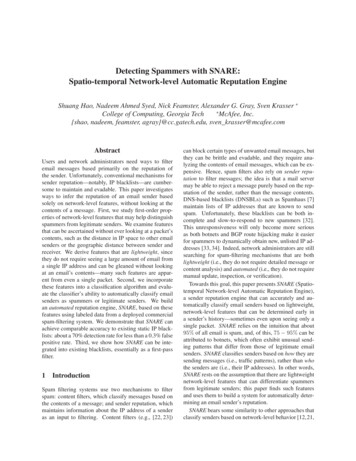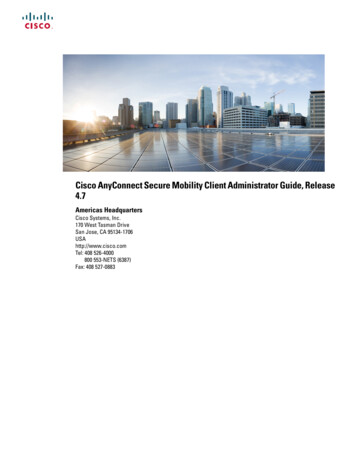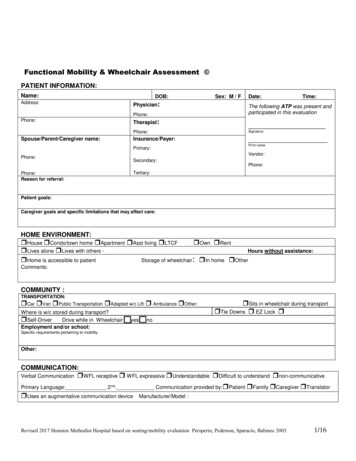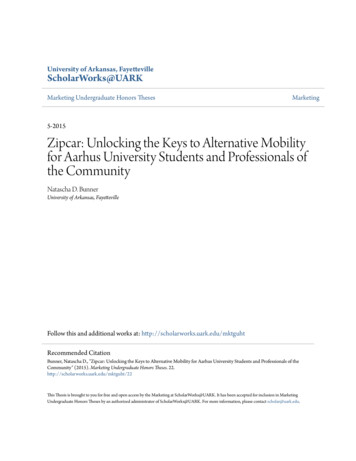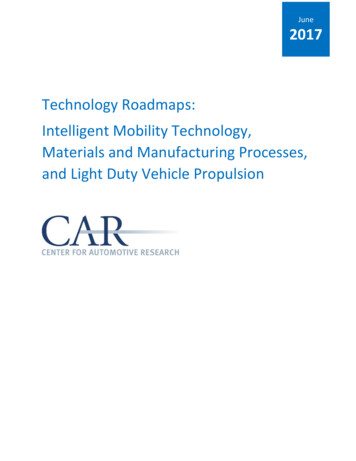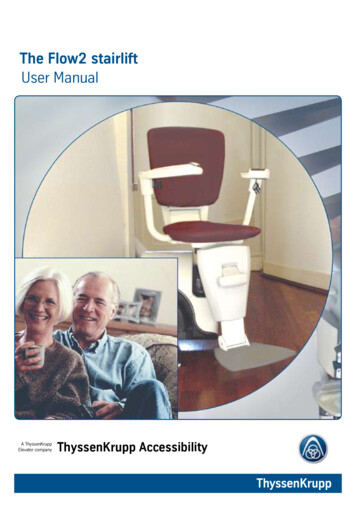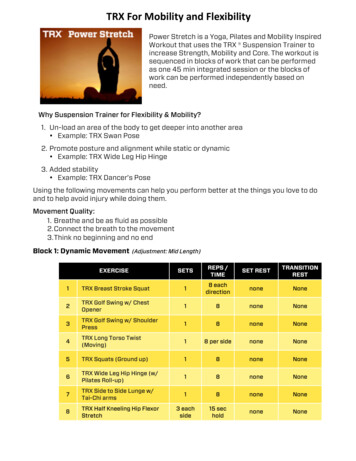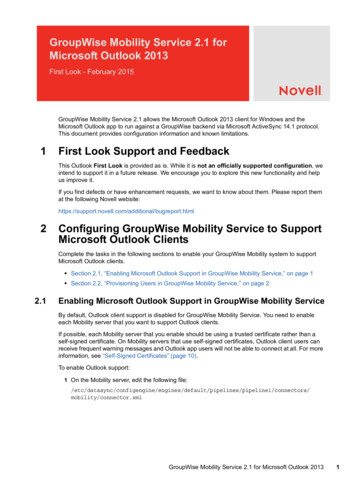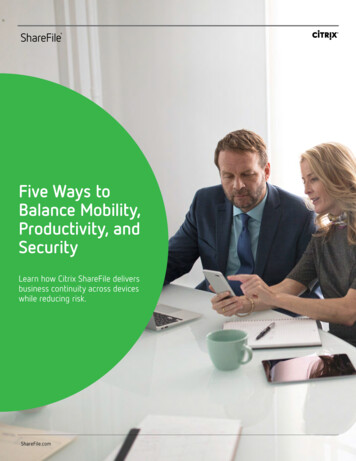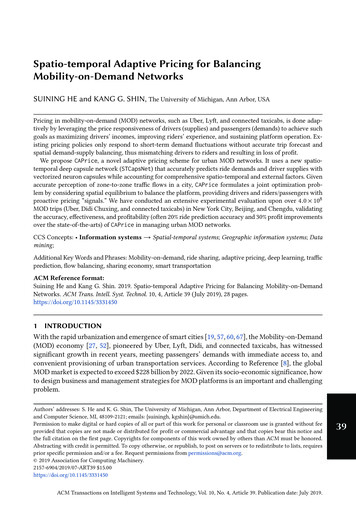
Transcription
Spatio-temporal Adaptive Pricing for BalancingMobility-on-Demand NetworksSUINING HE and KANG G. SHIN, The University of Michigan, Ann Arbor, USAPricing in mobility-on-demand (MOD) networks, such as Uber, Lyft, and connected taxicabs, is done adaptively by leveraging the price responsiveness of drivers (supplies) and passengers (demands) to achieve suchgoals as maximizing drivers’ incomes, improving riders’ experience, and sustaining platform operation. Existing pricing policies only respond to short-term demand fluctuations without accurate trip forecast andspatial demand-supply balancing, thus mismatching drivers to riders and resulting in loss of profit.We propose CAPrice, a novel adaptive pricing scheme for urban MOD networks. It uses a new spatiotemporal deep capsule network (STCapsNet) that accurately predicts ride demands and driver supplies withvectorized neuron capsules while accounting for comprehensive spatio-temporal and external factors. Givenaccurate perception of zone-to-zone traffic flows in a city, CAPrice formulates a joint optimization problem by considering spatial equilibrium to balance the platform, providing drivers and riders/passengers withproactive pricing “signals.” We have conducted an extensive experimental evaluation upon over 4.0 108MOD trips (Uber, Didi Chuxing, and connected taxicabs) in New York City, Beijing, and Chengdu, validatingthe accuracy, effectiveness, and profitability (often 20% ride prediction accuracy and 30% profit improvementsover the state-of-the-arts) of CAPrice in managing urban MOD networks.CCS Concepts: Information systems Spatial-temporal systems; Geographic information systems; Datamining;Additional Key Words and Phrases: Mobility-on-demand, ride sharing, adaptive pricing, deep learning, trafficprediction, flow balancing, sharing economy, smart transportationACM Reference format:Suining He and Kang G. Shin. 2019. Spatio-temporal Adaptive Pricing for Balancing Mobility-on-DemandNetworks. ACM Trans. Intell. Syst. Technol. 10, 4, Article 39 (July 2019), 28 pages.https://doi.org/10.1145/33314501 INTRODUCTIONWith the rapid urbanization and emergence of smart cities [19, 57, 60, 67], the Mobility-on-Demand(MOD) economy [27, 52], pioneered by Uber, Lyft, Didi, and connected taxicabs, has witnessedsignificant growth in recent years, meeting passengers’ demands with immediate access to, andconvenient provisioning of urban transportation services. According to Reference [8], the globalMOD market is expected to exceed 228 billion by 2022. Given its socio-economic significance, howto design business and management strategies for MOD platforms is an important and challengingproblem.Authors’ addresses: S. He and K. G. Shin, The University of Michigan, Ann Arbor, Department of Electrical Engineeringand Computer Science, MI, 48109-2121; emails: {suiningh, kgshin}@umich.edu.Permission to make digital or hard copies of all or part of this work for personal or classroom use is granted without feeprovided that copies are not made or distributed for profit or commercial advantage and that copies bear this notice andthe full citation on the first page. Copyrights for components of this work owned by others than ACM must be honored.Abstracting with credit is permitted. To copy otherwise, or republish, to post on servers or to redistribute to lists, requiresprior specific permission and/or a fee. Request permissions from permissions@acm.org. 2019 Association for Computing Machinery.2157-6904/2019/07-ART39 15.00https://doi.org/10.1145/3331450ACM Transactions on Intelligent Systems and Technology, Vol. 10, No. 4, Article 39. Publication date: July 2019.39
39:2S. He and K. G. ShinDemands (riders/passengers/customers/requesters) and supplies (drivers/cabs/vehicles) in MODmarkets dynamically change over time. Unless properly managed, mismatches between demandsand supplies (such as a sudden increase of ride-requests in a city zone with fewer drivers/cabsavailable nearby) can cause significant loss of revenue to MOD businesses and discourage bothcustomers and drivers. Since the drivers of many MOD (e.g., ride-sharing) platforms are oftenfreelancers rather than full-time workers, it is difficult in practice to enforce their spatio-temporalavailability directly.For MOD service to be adaptive to dynamically changing supplies and demands, a platform mustmonitor the market status and publish appropriate “signals”—pricing policies. Specifically, platforms such as Uber and Lyft post the real-time “heatmap” (discretized city zones) of ride-requeststo the drivers based on historical and recent data. In case of a sharp demand burst (say, Super Bowlnight) exceeding supplies somewhere, the platform increases the fare rate in those “hot” zones byapplying a certain multiplier to the standard rate (accompanied by dynamic subsidies to drivers).Such “surge pricing” [6, 38] (or “prime time,” as Lyft calls its version of Uber’s “surge pricing”) hasbeen adopted by many popular ride-sharing platforms.The surge pricing is to narrow the gap between supply and demand [6, 14]. First, more driversare enticed with potentially higher earnings, and hence move to hot zones and serve requeststhere. Second, customers who under-value the service will likely give up and seek alternativetransportation means, thus increasing the chance of matching drivers with the remaining customers. This profit-driven market’s self-adaptation [9] appears promising, but has not yet beenfully realized for the following reasons: Most existing demand/ride forecasts focus on a scalarbased time-series analysis, often modeling trips that connect zones locally/independently of eachother. Due to their simplicity and lack of realism, the demands displayed in drivers’ UIs have beenreported neither credible nor accurate [14]. Many of the drivers chasing surges have found little tolow demand when they arrive at the surge zones, earning less and thus getting discouraged. SomeMOD communities suggest inexperienced drivers ignore delayed surges,1 as the actual earnings ofblind/greedy surge chasing (so-called “bunch-up” or “wild-goose chase”) do not meet expectationsin practice.2The absence of proactive “signals” also exacerbates the supply-demand mismatch and incurslong waits for the passengers. Rather than affording surged or even uncapped prices (say, by Uber)again and again, passengers in need of timely rides prefer proactive distribution of vehicles w.r.t.location and time [7], particularly during rush hours. However, without joint balancing of vehiclesamong zones, reliance on only price surge cannot steer earning/profit-driven supplies towards demands in a timely and effective way. Due to the supply-demand imbalance, the surveys conductedin China [25] in 2017 show that 81.7% of respondents complained about more hailing difficultiesand up to 129.2% longer waiting time than in 2016. Starving demand, as intended by surge pricing,is not a sustainable option.As an inaccurate and delayed market signal, the conventional price surging cannot proactivelymatch the incoming ride requests, while driver supplies are not incentivized w.r.t. location andtime. After the initial MOD hype [8, 9], long-term service sustainability is thus often compromisedby such temporary profit-greedy control of conventional surges. Pricing signals are merely thelevers, not the sole and ultimate market goals.To improve service sustainability and platform utilization, we propose CAPrice, a novel adaptivepricing scheme for urban MOD networks. This adaptive pricing for mobility-on-demand dependson accurate perception of the dynamic market status and consequent fine-grained management.1 2 ber-drivers-dont-chase-surge/.ACM Transactions on Intelligent Systems and Technology, Vol. 10, No. 4, Article 39. Publication date: July 2019.
Spatio-temporal Adaptive Pricing for Balancing Mobility-on-Demand Networks39:3Fig. 1. Illustration of adaptive pricing and balancing for MOD networks.As shown in Figure 1, it uses the historical MOD service requests and rides to forecast the demandsupply patterns in the near future (say, a few minutes later). Then, it jointly optimizes the pricingpolicies based on profit, market control, and sustainable service (zone balancing), bridging thesignal (price, subsidy) and market (demand, supply) spaces via more responsive connections. Byadaptively matching the spatio-temporal pricing signals with the market divisions, the suppliesmeet demands spatially and proactively.Specifically, we first design a spatio-temporal ride prediction scheme based on deep capsule neural network, called STCapsNet, which accurately forecasts future demands/supplies via structuraland vectorized capsules—structured groups of neurons [51]. The neurons in each capsule producea vector, taking into account essential spatial hierarchies between simple and complex objects inan input image. Considering input pick-up/drop-off distributions as images, STCapsNet capturesthe inherent correlations between pixels (city zones) by a novel vectorization structure, acquiringfar more knowledge than conventional scalar-based approaches, including convolutional neuralnetwork (CNN) [51].Based on more accurate demand/supply predictions, CAPrice formulates a joint optimizationframework, anticipating prices and subsidies towards incoming ride-requests and thus incentivizing drivers more responsively to customers than previous greedy surge-chasing. In particular, withthe formulation of spatial equilibrium in the vehicle (re)distribution and long-term ride-requestpatterns, CAPrice follows the spirit of dynamic pricing [9] but jointly optimizes the distributionsof incentive-compatible prices and subsidies for the coming rides. Therefore, CAPrice proactivelyhandles demand-supply imbalances via more responsive driver flows between zones.The main contributions of this article are: Accurate Prediction of Ride Requests via a Spatio-Temporal Capsule Network (Section 4):CAPrice leverages STCapsNet to comprehensively capture the inherent pick-up/drop-offrelationship among city zones by the novel vectorized neuron structures. Integrated withspatio-temporal ride distributions and external ride factors, STCapsNet achieves highly accurate prediction of rides in complex urban networks. Adaptive Pricing for Mobility-on-Demand (MOD) Platforms (Section 5): CAPrice augmentsthe MOD platforms with enhanced responsiveness to spatio-temporal demand-supply fluctuations and adaptive pricing for profit and utilization maximization. Specifically, it takesthe forecasts of dynamic demand-supply patterns as input and incentivizes the proactivedistribution of drivers adaptively towards customer demands, thus achieving profitable andsustainable platform operation. Large-scale Data-driven MOD Network Studies (Section 6): We have conducted extensivedata-driven studies to validate the accuracy, effectiveness, and profitability of CAPrice. OurACM Transactions on Intelligent Systems and Technology, Vol. 10, No. 4, Article 39. Publication date: July 2019.
39:4S. He and K. G. Shinexperimental evaluation based on large-scale MOD data (more than 4.0 108 trip recordsin total) from New York City, NY, as well as Beijing and Chengdu, China, has shown thatCAPrice can accurately predict ride (demand/supply) patterns (often reducing error by morethan 25% over state-of-the-art [39, 66]) and provide a more profitable pricing guideline forMOD networks (often 30% more revenues, faster market clearance, and shorter wait timethan conventional pricing policies of exiting platforms [14, 35, 37]).Besides the latest comprehensive validation of the application of capsule-networks [51], we establish critical profit-maximizing insights as deployment references for the MOD platforms, suchas pricing the over-demanded zones more spatio-temporally, while subsidizing their unattractivebut demanded peers more, especially those unbalanced ones due to their highly attractive neighbors. The importance of ride prediction accuracy to market pricing is also demonstrated. WithCAPrice’s joint formulation of market forecasting and pricing, we expect that the MOD platforms would benefit both by accounting for predictable demand-supply patterns (say, morningrush hours) while smoothing out short-term fluctuations (say, due to weather conditions).Despite the current prototype studies on urban ride-sharing [5, 21] and connected taxi [25], thegeneral framework of CAPrice can be easily extended to other emerging autonomous or connectedMOD services, such as self-driving rental cars [43, 47].The rest of this article is organized as follows: After discussing the related work (Section 2), wefirst overview the concepts, problems, and framework (Section 3). Then, we present capsule network design for ride prediction (Section 4) and joint optimization formulation of adaptive pricing(Section 5). Our prototype is evaluated with MOD datasets (Section 6), followed by deploymentdiscussions (Section 7) and concluding remarks (Section 8).2RELATED WORKWe briefly review the related work and discuss its differences from CAPrice.Traffic Prediction: With the growing need of handling more complex city systems [67], therehave been numerous efforts in urban traffic analytics, enabled by the advent of mobile/big datascience [58, 64, 66] and IoT [20, 41, 60]. Beyond the previous studies applying “shallow” modelstructures [34, 53, 65], deep learning, powered by growing datasets and advancing parallelism, hasemerged as more versatile and promising traffic analytics [54]. Recurrent neural networks (RNNs),enhanced by long-short-term memory (LSTM) techniques [24], learn the scalar-based traffic sequence. Based on the success in understanding photos [30], CNN is explored for traffic monitoring [39], modeling neighborhood regions into scalars and locally capturing (poolin
-on-DemandNetworks 39:3 Fig.1. works. AsshowninFigure1 .
